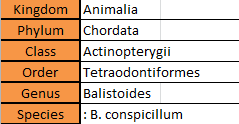The Clown triggerfish (Balistoides conspicillumes) is one of the most colorful fish that can be found in coral reefs). It belongs to the order of the Tetradontiformes and the Balistidae family. Join us to know everything about them.

Although the Clown triggerfish is not very friendly with divers, it represents an unparalleled opportunity to make a beautiful underwater photography. Known as «The clowns of the family of triggerfish» adults can reach a size of up to 50 cm.
Table Of Content
Taxonomy

The Clown Triggerfish’s Main Characteristics
The Clown triggerfish is one of the most beautiful and original fish in the marine world, so it’s also one of the most persecuted by marine photographers. It’s related to the puffer fish. All these families have very hard skin in common.
Their adaptation to the aquarium is easy and although they seem to be very resistant fish, there have been cases of sudden deaths, so we must be very careful with them, especially during their first days in the aquarium.
Morphology
In freedom Clown Triggerfish can reach up to 50 centimeters long, but in the aquarium they rarely exceed 25 centimeters.
They have an oval and laterally compressed body and an erectile spine in the first radius of their dorsal fin (like all Triggerfis).
The second radius of their dorsal fin allows the spine to be unlocked, keeping it in position. But the most distinctive feature of its anatomy is its color.
The Clown triggerfish is black, dotted with white spots in its ventral area, which reach up to slightly more than half of its anatomy. Around the dorsal fin it has a large yellow spot, dotted with black spots.
The snout is bright yellow edged with a white stripe. It has other yellow spots near the caudal fin, dotted with white spots.
 As for their eyes, they are small and placed laterally. Under the eyes Clown triggerfish have a white stripe, which can sometimes be yellow.
As for their eyes, they are small and placed laterally. Under the eyes Clown triggerfish have a white stripe, which can sometimes be yellow.
The coloration of younger specimens is slightly different from adults. They may also have white spots in the dorsal area, although the species’ characteristics colors fade and appear as they age. We invite you to read our article the anatomy of fish to learn more about such an interesting topic
Where Do Clown Triggerfish Inhabit?
The Clown triggerfish are widespread in the tropical waters of the Indian and Pacific Oceans. They usually live in the surroundings of coral reefs, in surface waters that can reach 75 meters deep. In the reefs and rocky areas is where they find their food: oysters, lobsters, crabs, prawns…
How Do Clown Triggerfish Reproduce?
The Clown Triggerfish digs its nests in the sand, where it creates a hollow to spawn. Both the male and the female will protect the nest, until the eggs hatch and the fry begin to swim.
They are quite aggressive in protecting the nest, and it’s known that they delimit an area around it in the form of an inverted cone, so that the area to be protected is larger on the surface than on the edge of the nest. It’s best to get away from their nest, so as not to be attacked.
Threats
 The main threat for these really striking creatures is the marine aquarium trade. These beautiful fish are caught in large quantities to meet the demand of aquarium fans, although they live for a short time in confined waters.
The main threat for these really striking creatures is the marine aquarium trade. These beautiful fish are caught in large quantities to meet the demand of aquarium fans, although they live for a short time in confined waters.
What Do Clown Triggerfish Feed On?
The Clown Triggerfish powerful teeth can eat all kinds of mollusks. In nature they feed on oysters, mussels, crabs , prawns, small fish … their appetite is voracious, they eat a lot and fast.
In the aquarium its food consists of Nereis, mussels, fresh or freeze-dried prawns and squid.
Clown Triggerfish in Aquariums.
The aquarium should be wide, minimum of about 1,000 liters, where we will see them swim in the intermediate levels. Shelters must be provided, either with corals or with aquarium rocks that allow them to hide.
Water quality must be moved in the following parameters:
√ Temperature: between 24ºC and 26ºC

√ Salinity: between 1,023 and 1,025
√ pH: between 8.1 and 8.4
√ gH: between 8º and 12º
√ They adapt with more ease in aquariums with some water movement.
Behavior and Compatibility
Its relationship with other species varies depending on the aquarium’s size.They won’t have any problem as long as they have enough space and that others don’t bother them, since Clown Triggerfish are quite lonely fish. We invite you to read our articlewhite banded triggerfishto learn about other species of this family
Ideally they should share space with species of the same size or larger, since with smaller ones they may end up being part of their meal.
Let’s watch them
